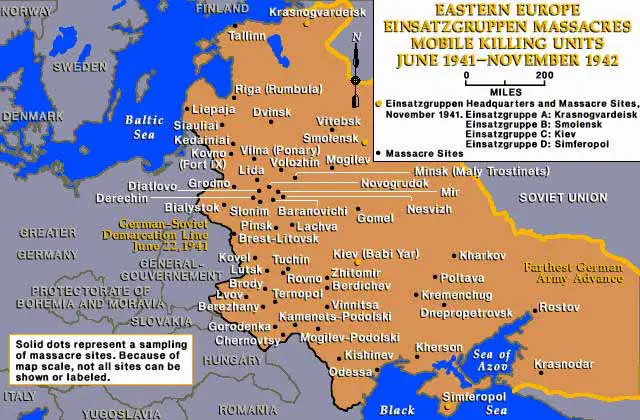The Mobile Killing Squads
After the German army invaded the Soviet Union on June 22, 1941, a new stage in the Holocaust began. Under cover of war and confident of victory, the Germans turned from the forced emigration and imprisonment of Jews to mass murder. Special action squads, or Einsatzgruppen, made up of Nazi (SS) units and police, moved with speed on the heels of the advancing German army. Their job was to kill any Jews they could find in the occupied Soviet territory. Some residents of the occupied regions, mostly Ukrainians, Latvians, and Lithuanians, aided these German mobile killing squads by serving as auxiliary police.
The mobile killing units acted swiftly, taking the Jewish population by surprise. The killers entered a town or city and rounded up all Jewish men, women, and children. They also took away many Communist party leaders and Roma (Gypsies). Victims were forced to surrender any valuables and remove their clothing, which was later sent for use in Germany or distributed to local collaborators. Then the killing squad members marched their victims to open fields, forests, and ravines on the outskirts of conquered towns and cities. There they shot them or gasses them in gas vans and dumped the bodies into mass graves.

On September 21, 1941, the eve of the Jewish New Year, a mobile killing squad entered Ejszyszki, a small town in what is now Lithuania. The killing squad members herded 4,000 Jews from the town and the surrounding region into three synagogues, where they were held for two days without food or water. Then, in two days of killing, Jewish men, women, and children were taken to cemeteries, lined up in front of open pits, and shot to death. Today there are no Jews in Ejszyszki. It was one of hundreds of cities, towns, and shtetls whose Jews were murdered during the Holocaust. The rich culture of most of these Jewish communities was lost forever.
The killing squads murdered more than a million Jews and hundreds of thousands of other innocent people. At Babi Yar, near Kiev, about 34,000 Jews were murdered in two days of shooting. Only a few people in the general population helped their Jewish neighbors escape. Most people were afraid that they too might be killed.
The massacres of innocent men, women, and children in Babi Yar and other towns were not the crimes of hoodlums or crazy men. The executioners were "ordinary" men who followed the orders of their commanding officers. Many of the killers had wives and children back in Germany. Propaganda and training had taught many members of the mobile killing squads to view their victims as enemies of Germany. Some killers drank heavily to dull their thoughts and feelings. In addition, when they described their actions they used code words like "special treatment" and "special action" instead of "killing" or "murder" to distance themselves from their terrible crimes.


